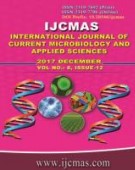


 National Academy of Agricultural Sciences (NAAS)
National Academy of Agricultural Sciences (NAAS)

|
PRINT ISSN : 2319-7692
Online ISSN : 2319-7706 Issues : 12 per year Publisher : Excellent Publishers Email : editorijcmas@gmail.com / submit@ijcmas.com Editor-in-chief: Dr.M.Prakash Index Copernicus ICV 2018: 95.39 NAAS RATING 2020: 5.38 |
The study was conducted to know the adoption status of various recommended sowing practices in protected cultivation of vegetables in six districts of Punjab viz., Amritsar, Gurdaspur, Sangrur, Moga, Jalandhar and Kapurthala. A total of 150 respondents were selected for the study by probability proportion of number of farmers practicing protected vegetable cultivation from the selected districts and the data were collected by personally interviewing the respondents. The results revealed that maximum number of respondents (64.37%) grown capsicum in protected structures followed by 58.62 per cent for cucumber and 21.84 per cent for tomato crop in the protected structures. Majority of growers preferred poly house for cultivation of these crops followed by net house. Neem cake, trichoderma and vermicompost were mostly used by respondents under protected structures. Study also revealed that majority of the respondents adopted soil testing practices to get the actual micronutrient status of soil, shallow soil ploughing and applied organic formulation before sowing of crops under protected structures. Majority of tomato growers followed soil solarisation practices under protected structure to reduce the soil born infections. Majority of capsicum and tomato grower prepare their own nursery and used pretreated seed under protected structures. Majority of capsicum and tomato growers did not adopt recommended seed rate and sowing time practices. Majority of tomato growers did not adopt recommended spacing practices while adopt recommended transplanting time practices while in capsicum, maximum number of growers adopt recommended spacing practices and did not adopt recommended transplanting time practices. In case of cucumber, majority of respondents did not adopt recommended seed rate, spacing practices, used pretreated seed and adopt recommended sowing time practices. Therefore regular awareness camps and training courses should be organised to train the farmers for successful cultivation of vegetable crops under protected structures and adoption of these technologies at large scale.
 |
 |
 |
 |
 |